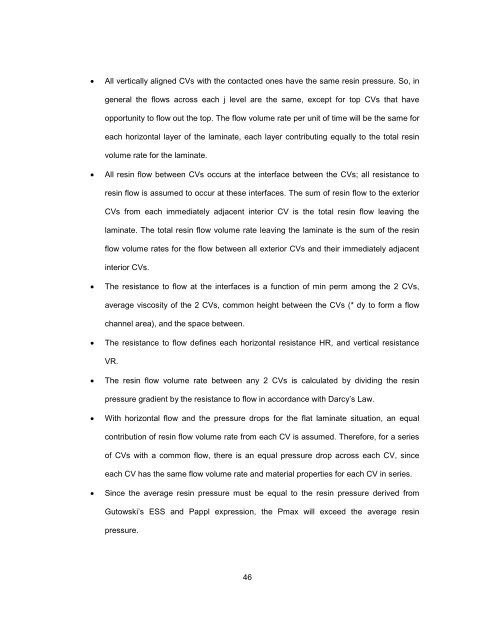TOOLED THICK COMPOSITES by ARVEN H. SAUNDERS III ...
TOOLED THICK COMPOSITES by ARVEN H. SAUNDERS III ...
TOOLED THICK COMPOSITES by ARVEN H. SAUNDERS III ...
You also want an ePaper? Increase the reach of your titles
YUMPU automatically turns print PDFs into web optimized ePapers that Google loves.
• All vertically aligned CVs with the contacted ones have the same resin pressure. So, in<br />
general the flows across each j level are the same, except for top CVs that have<br />
opportunity to flow out the top. The flow volume rate per unit of time will be the same for<br />
each horizontal layer of the laminate, each layer contributing equally to the total resin<br />
volume rate for the laminate.<br />
• All resin flow between CVs occurs at the interface between the CVs; all resistance to<br />
resin flow is assumed to occur at these interfaces. The sum of resin flow to the exterior<br />
CVs from each immediately adjacent interior CV is the total resin flow leaving the<br />
laminate. The total resin flow volume rate leaving the laminate is the sum of the resin<br />
flow volume rates for the flow between all exterior CVs and their immediately adjacent<br />
interior CVs.<br />
• The resistance to flow at the interfaces is a function of min perm among the 2 CVs,<br />
average viscosity of the 2 CVs, common height between the CVs (* dy to form a flow<br />
channel area), and the space between.<br />
• The resistance to flow defines each horizontal resistance HR, and vertical resistance<br />
VR.<br />
• The resin flow volume rate between any 2 CVs is calculated <strong>by</strong> dividing the resin<br />
pressure gradient <strong>by</strong> the resistance to flow in accordance with Darcy’s Law.<br />
• With horizontal flow and the pressure drops for the flat laminate situation, an equal<br />
contribution of resin flow volume rate from each CV is assumed. Therefore, for a series<br />
of CVs with a common flow, there is an equal pressure drop across each CV, since<br />
each CV has the same flow volume rate and material properties for each CV in series.<br />
• Since the average resin pressure must be equal to the resin pressure derived from<br />
Gutowski’s ESS and Pappl expression, the Pmax will exceed the average resin<br />
pressure.<br />
46
















